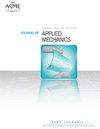多层壳通过摩擦相互作用
IF 2.8
4区 工程技术
Q2 MECHANICS
引用次数: 0
摘要
我们提出了多层等几何Kirchhoff—Love (KL)壳的新公式,其中各层假设通过无穿透和摩擦接触相互作用。这项工作在很大程度上是由b[1]中提出的实验和分析所推动的。我们利用库仑摩擦定律的正则化版本来模拟接触壳表面之间的切向牵引力。为了确保摩擦模型的客观性(即参考帧不稳定性),我们提出了两种不同的策略来推断接触界面处接触对的速度矢量:(i)使用单个壳层的底层KL运动学和(ii)使用基于泰勒级数的扩展。我们通过一个数值基准示例比较了两种方法的性能。然后,我们使用[1]的“带有内摩擦的书的弯曲响应”实验验证了我们的多层壳公式。本文章由计算机程序翻译,如有差异,请以英文原文为准。
Multilayer Shells Interacting Through Friction
We present a new formulation for the multilayer Isogeometric Kirchhoff--Love (KL) shells, where the individual layers are assumed to interact through no-penetration and frictional contact. This work is largely motivated by the experiments and analysis presented in [1]. We utilize a regularized version of Coulomb's friction law to model the tangential traction between the contacting shell surfaces. To ensure objectivity (i.e., reference-frame invariance) in the frictional model, we propose two different strategies to extrapolate the velocity vectors of the contact pair at the contact interface: (i) Using the underlying KL kinematics of the individual shell layers and (ii) Using the Taylor series-based extension from [2]. We compare the performance of both approaches through a numerical benchmark example. We then validate our multilayer shell formulation using the ‘bending response of a book with internal friction’ experiments of [1].
求助全文
通过发布文献求助,成功后即可免费获取论文全文。
去求助
来源期刊
CiteScore
4.80
自引率
3.80%
发文量
95
审稿时长
5.8 months
期刊介绍:
All areas of theoretical and applied mechanics including, but not limited to: Aerodynamics; Aeroelasticity; Biomechanics; Boundary layers; Composite materials; Computational mechanics; Constitutive modeling of materials; Dynamics; Elasticity; Experimental mechanics; Flow and fracture; Heat transport in fluid flows; Hydraulics; Impact; Internal flow; Mechanical properties of materials; Mechanics of shocks; Micromechanics; Nanomechanics; Plasticity; Stress analysis; Structures; Thermodynamics of materials and in flowing fluids; Thermo-mechanics; Turbulence; Vibration; Wave propagation

 求助内容:
求助内容: 应助结果提醒方式:
应助结果提醒方式:


